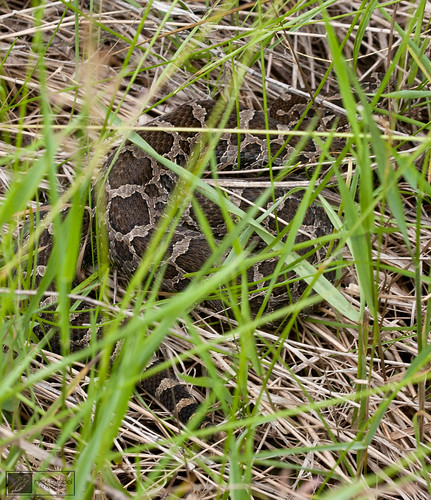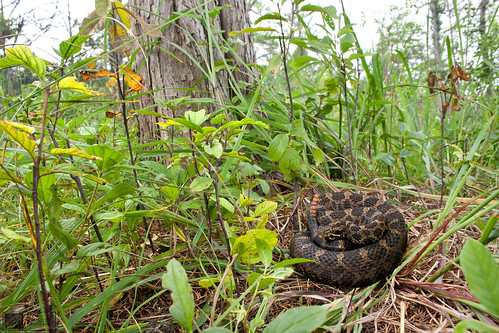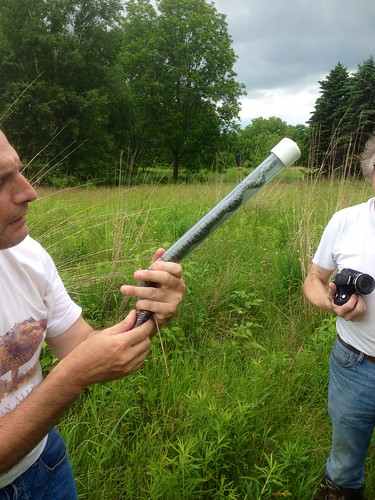 |
| Adult male EMR, particularly dark for this locale. |
A handsome snake, though exceedingly dark for this location. The snake was measured, weighed, and given a unique identification number as part of an ongoing mark-recapture study on site. After a brief lunch, we set out to another area of the property to walk some upland fields which serve as summer habitat for massasaugas. One field in particular has yielded good numbers of snakes in the past for me over the summer months. And with an overcast sky and temps in the low 70s, I was optimistic about our chances. We split about 10 feet apart, and walked as a group, combing the area for a dark shape coiled amongst the tall grass. It wasn't long before I noticed a freshly shed female try to soak up whatever warmth she could on this overcast day.
 |
| Gravid female EMR, trying to remain hidden in the grass. |
This was a new snake, a young gravid female. Like other captured snakes, data was taken and she was given a unique identification number. She was then released exactly where she was found. The mark-recapture study at this location is part of a much larger habitat restoration project. Population estimates and trends are vital information as the habitat management at this site moves forward.
 |
| A large adult Eastern Massasauga Rattlesnake (Sistrurus catenatus) at home in a prairie fen. |
Though I can't always help out with surveys, I keep my own personal records on massasauga observations, trends, and health of snakes at various locations across southeast Michigan. Changes in numbers of observations or succession of habitats isn't necessarily concrete scientific data, but it is observational data which can help. I'll be sharing some more posts over the course of the winter on massasaugas, particularly from the fall months at a location or two that are pretty incredible, but show signs of trouble from the ever encroaching snake fungal disease (SFD). Until then, keep warm!




canada goose jackets
ReplyDeletecheap jordans
fitflops clearance
puma shoes
nike shoes
polo ralph lauren factory store
nike wholesale
coach outlet
canada goose coats
coach factory
hollister.com
rolex watches for sale
mbt shoes
coach outlet store online clearances
jordan 6
north face jackets
michael kors bags sale
ugg boots clearance
prada outlet
columbia outlet
chanel handbags
cheap jordan shoes
canada goose discount
michael kors outlet
fake jordans
cheap nike
louis vuitton outlet
nike nfl jerseys
hollister.com clothing
hollister outlet store
hollister clothing
kate spade outlet
coach handbags online outlet
coach wallets outlet
ralph lauren outlet
girls jordans
cheap canada goose coats
cheap michael kors handbags
ferragamo shoes sale
ralph lauren outlet online
cheap gucci belts
kids north face
fitflops sale clearance
fitflops sale
ugg boots sale 2015LXY
Are you done with this blog? It's honestly been quite helpful, but I notice you haven't posted anything in two years. I understand that this blogging life is fairly stressful, but I, and a lot of your old readers, would probably be interested in reading what's happened.
ReplyDelete